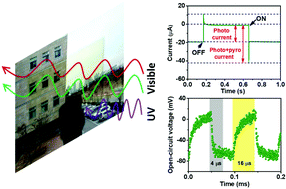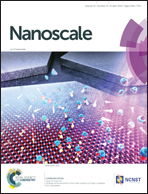High-performing ultrafast transparent photodetector governed by the pyro–phototronic effect†
Abstract
In this work we utilized the advantage of the photo-induced pyroelectric effect – known as “Pyro–phototronic” – to design a self-powered, ultrafast, transparent ultraviolet (UV, 365 nm) photodetector. The device architecture contains an UV absorbing pyroelectric ZnO layer sandwiched between hole-selective V2O5 and a bottom ITO electrode. In addition, the device shows a high optical transmittance, >70%, in the entire visible region. The photo current of the device was enhanced from 19 to 42 μA under pulsed UV light illumination (λ = 365 nm, 4 mW cm−2) by exploiting the pyro–phototronic potential. In addition, the photodetector demonstrated ultrafast responses of ∼4 μs for the rise time and ∼16 μs for the fall time. Further, a high photoresponsivity of ∼36.34 mA W−1 and excellent photodetectivity of ∼6.04 × 1014 Jones, with an enhancement of 725% in both due to the pyroelectric potential, were measured. This novel approach will open a new path to design transparent and ultrafast devices, as well as on the flexible substrates, for future optoelectronic applications.



 Please wait while we load your content...
Please wait while we load your content...